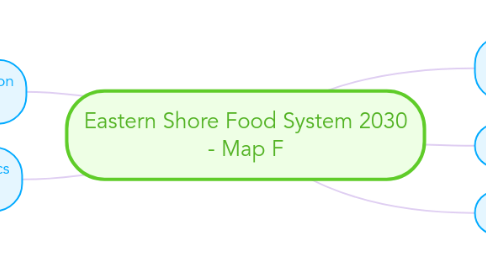
1. Regional marketing plus distribution system
1.1. Harden demand in institution
1.2. Direct marketing to stores/consumers
1.2.1. Farmer education in systems
1.2.1.1. Community education at the same time
1.2.1.2. Family life must include food education
1.2.1.3. Future harvest/CASA
1.2.1.4. How do they get educated?
1.2.1.4.1. Eastern shore experiential learning
1.2.1.4.2. Chesapeake college! And K-12!
1.2.1.4.3. U.M extension
1.2.1.5. Need to make sure newly educated farmers have access to land, capital and markets
1.2.1.5.1. Yes, that's a challenge
1.3. SUMMARY: Business plan for regional food production; marketing plus distribution mandates education of farmers to students, land and capital to farmers, and food for less fortunate
2. Producers are using antibiotics responsibly
2.1. The good for 2030
2.2. Many people disagree
2.3. Idea 3
2.3.1. Not all growers do
2.4. Snap vouchers can be used to buy farm produce anywhere
2.4.1. Do we realign economics of retail food cost?
2.4.2. But farmers market don't see many snap customers
2.4.2.1. Partner with school districts to provide school food?
2.4.2.2. Transportation to farmers markets is an issue
2.4.2.2.1. Farmers market mobile?
2.4.2.3. Urban markets do
2.4.2.3.1. I'd like to see a county gardens in every community/town
2.4.2.3.2. What is the barrier for rural then? Transition knowledge do where/when mariatis? Etc.
2.4.2.4. And snap consumers need to be educated on how to eat healthy food
2.4.2.4.1. This is true of most people. Use of social benefits is not a character/education issue
2.4.2.5. So true because only 2 take snap at Easton
2.4.2.5.1. Move farmers markets on a different date to where the poor are
2.4.2.5.2. this can be addressed with a shared register at market
2.5. SUMMARY: Farmers Markets: access low income communities and use of SNAP. Community Gardens: educate people
3. Will we be able to grow produce instead of food?
3.1. Lots of apply to diversity grain as well - distilleries beer – future: home all good for the Bay
3.2. Yes – Caroline, Kent, Dorchester all grant for produce / plenty of demand
3.2.1. Talbot land does not grow produce
3.2.1.1. No! Lots of growers in Talbot!
3.2.1.2. Why?
3.2.1.2.1. Clay soil
3.2.1.2.2. Poor soil for produce
3.2.2. What proportion of agriculture is grown for human consumption? Can we grow more produce, etc. for direct markets/ expand on what is already here?
3.2.2.1. All in relation to what they can sell
3.2.3. I hope Talbot can do it too
3.2.4. Go organic as fast as possible, Shore wide to gain money
3.2.4.1. Organic is expensive to buy
3.2.4.2. Do statistics support this ?
3.2.4.2.1. Yes!
3.2.4.3. What about school purchasing mandates that require perfect vegetables. Hard to deal with organics
3.2.4.3.1. also consumers are always looking for "perfect" foods – need to change that too
3.2.4.3.2. Why? That's absurd!
3.2.4.3.3. How can we change these mandates?
3.2.4.3.4. That vision of perfect food needs to change
3.2.4.3.5. Gardens in every school with food. The children grow used in lunches and snacks
3.3. SUMMARY: can our area begin to transition to producing more food for people (over livestock) if we incorporate organics, greenhouses, etc. and work with local produce mandates and marketing initiatives? [we need to consider soil type.]
4. Will we still have farms?
4.1. If we want to eat, yes
4.2. Good point
4.2.1. Farms don't have a strong tax base so how do communities strike a balance
4.2.1.1. Investment grants to increase market for p roducts locally.
4.3. What are other alternatives?
4.3.1. Counties need clean industry
4.4. Family farms or corporate farms?
4.4.1. That's a real problem for the future
4.4.1.1. Because?
4.4.1.2. Which one is the problem? Or is it both?
4.4.1.2.1. Corporate is a problem
4.4.1.2.2. People have a sense of ownership are better stewards
4.4.2. Does it matter?
4.4.2.1. No, if the corporate farms treat workers, employees, etc. well
4.4.2.1.1. Agreed, there is a role to both. Can't exclude corporate
4.4.2.1.2. Just money doesn't equal quality of life
4.4.2.2. Not if we can keep the profits local
4.4.2.2.1. Better production/distribution system
4.5. Diversifying should increase resilience. Monoculture is risky!
4.5.1. Yes!
4.5.2. Suggestions for diversifying?
4.5.2.1. Barley, hemp, organic grain produce
4.5.2.2. Allocate at least small areas on grainfarms for produce?
4.6. SUMMARY: in 2030, will we still have farms that thrive and are sustainable? What kind will they be and who will be operating them, corporations or small farmers? What will be the product mix?
5. Jobs machine for Eastern Shore
5.1. Our economy needs help!
5.1.1. Only we can do it
5.1.2. It needs vision of a coherent plan
5.1.3. Use the growing demand for ABF – free organic responsible meat
5.1.3.1. Potential to build organic meat processing facility on shore
5.1.3.1.1. Demand is increasing
5.1.4. Processing and value add is a pathway to higher wage jobs
5.1.4.1. In farming?
5.1.4.2. Direct to answer/stores produces more money to farms
5.1.4.2.1. Yes, and direct means local
5.2. Build a strategic main street market economy
5.2.1. That would be great!
5.2.2. Definite problem/potential and Caroline
